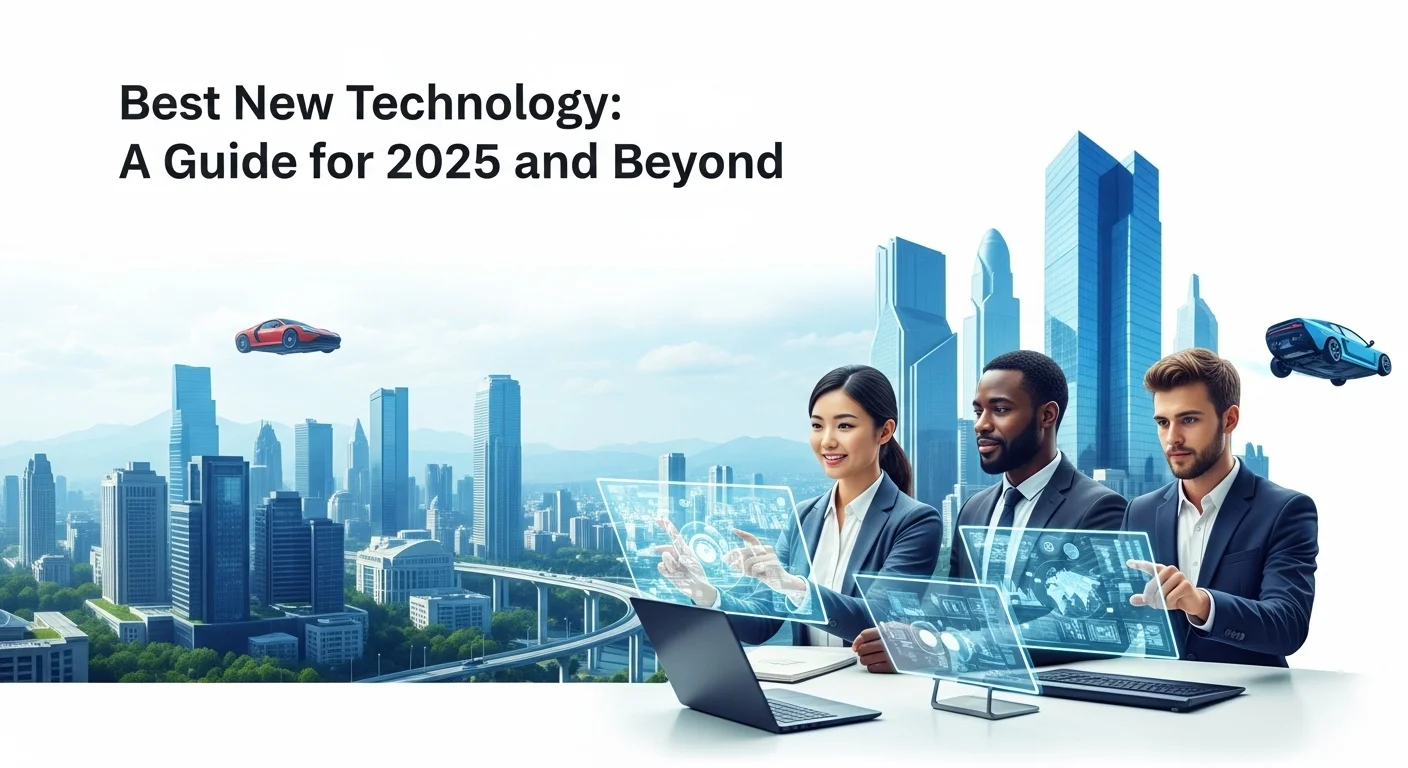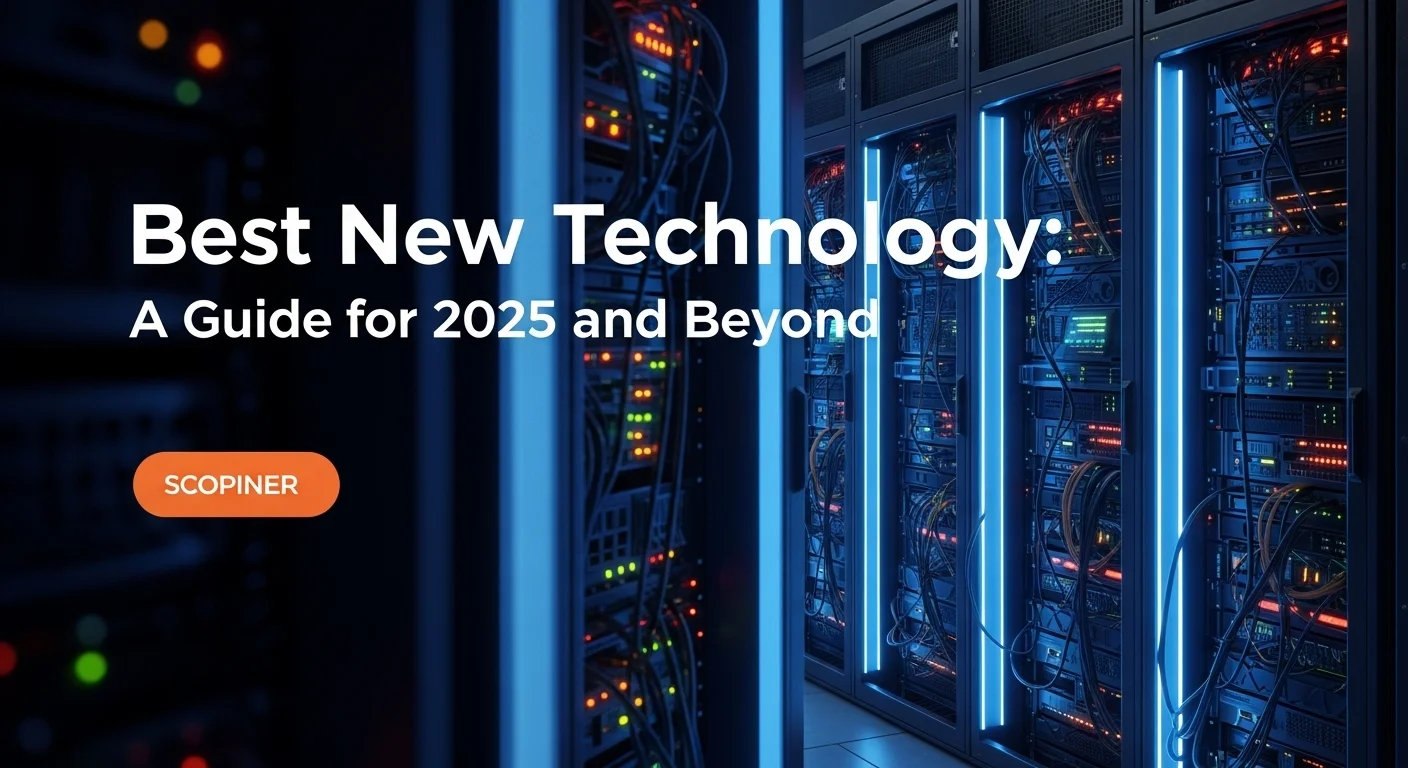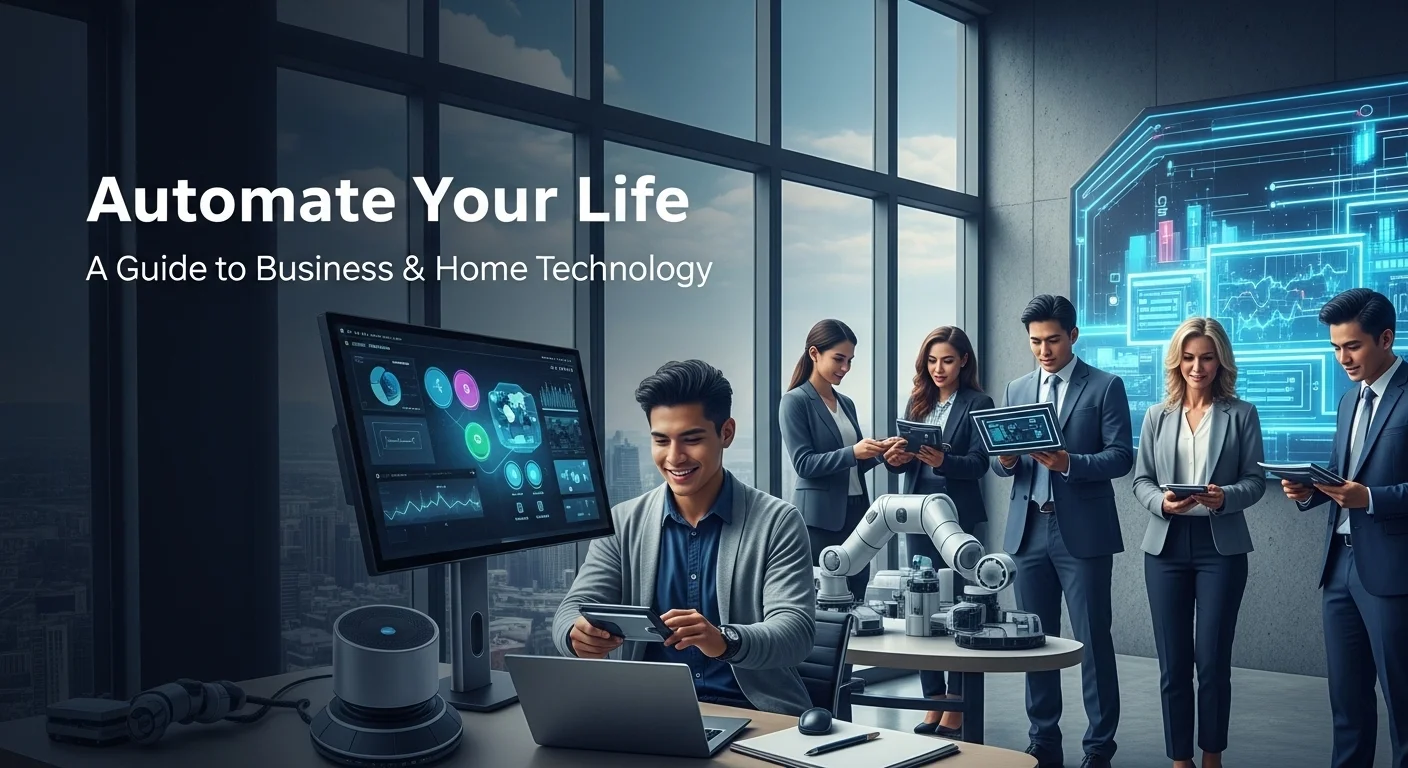The 2025 Tech Playbook: Key Trends and Business Ideas You Can't Ignore

Executive Summary
After two decades in tech, I've seen countless trends come and go. The key isn't to chase every new thing, but to understand the fundamental shifts that are here to stay. This guide is my take on what's truly shaping our future. We'll cut through the hype to see how technologies like Artificial Intelligence, next-gen Cybersecurity, and smarter Cloud Computing are creating real-world opportunities. I'll share what I've learned about identifying solid business ideas in this landscape, from game-changing startups to smart integrations for established companies. Think of this as a conversation about navigating what's next, using my experience to give you the insights you need to build something valuable and lasting.
Table of Contents
Decoding the 'Next Big Thing': What Tech Truly Matters?
In the world of technology, we love to talk about the 'next big thing.' But what does that really mean? From my perspective, it’s not about flashy gadgets; it's about the powerful, foundational shifts that create new ways to do business and live our lives. When I talk about emerging tech, I’m talking about innovations with the power to solve real problems, open up new markets, and give entrepreneurs a genuine shot at building something amazing. It's about spotting the shifts that create the best ground for new business ideas to flourish. For a startup, this means finding an untapped niche. For a big company, it’s about knowing which tools will keep you relevant.
Why is this so critical right now? Because the pace of change has never been faster. I've seen companies that were industry leaders become irrelevant in just a few years because they ignored the writing on the wall. The businesses that thrive are the ones that are constantly curious. They are the ones looking for smart ways to use these new tools to get a competitive edge, work more efficiently, and give customers what they want before they even know they want it. This constant evolution is what makes it possible for agile small businesses to outmaneuver giants, often by simply adopting a new piece of technology more cleverly.
The Core Pillars of Tomorrow's Tech
To really get a handle on what’s coming, I find it helps to look at the four main pillars where the most exciting changes are happening. These areas don't exist in a vacuum; they feed into and accelerate each other.
1. Artificial Intelligence (AI) and Machine Learning (ML)
AI is, without a doubt, the most powerful force in tech today. We've moved past the sci-fi concepts. AI is now a practical tool that can learn, reason, and even create. The real breakthroughs I’m seeing are in areas like Generative AI, which can write code or create stunning images, and Explainable AI (XAI), which helps us understand *why* an AI made a certain decision. The opportunities here are immense, from AI tools that help doctors diagnose diseases earlier to platforms that offer incredibly personalized customer experiences.
2. Next-Generation Cybersecurity
As everything moves online, the need for robust security has exploded. I've worked with too many businesses that learned this the hard way. The new frontier in cybersecurity isn't just about building walls; it's about intelligent defense. We're talking about AI systems that hunt for threats in real-time and security philosophies like 'Zero Trust,' where you don't automatically trust anyone, inside or outside your network. For an entrepreneur, offering specialized, easy-to-manage cybersecurity services for small businesses is one of the most valuable ventures you could start today.
3. Smarter Cloud Computing
The cloud has been a game-changer for over a decade, giving anyone with an idea access to supercomputer-level power. But it's still evolving. The exciting developments now are around things like Serverless and Edge Computing. Serverless lets you run your app without ever thinking about the underlying hardware, and Edge Computing moves processing power closer to where it's needed, like a factory floor or a retail store, for instant results. The cloud is the foundation of almost every modern business, and helping companies manage their cloud costs and architecture is a booming and necessary field.
4. The Connected World: IoT and Home Automation
The Internet of Things (IoT) is the quiet revolution of connecting everyday objects to the internet. Think of everything from the fitness tracker on your wrist to the smart sensors that monitor a city's traffic. Home automation is the part of IoT we interact with daily, making our homes more comfortable, secure, and efficient. The big push now is to make these devices smarter with AI and, crucially, to make them work together seamlessly. I’ve seen incredible startups built around creating custom smart home experiences or developing IoT solutions for specific industries, like agriculture or logistics.
How This Tech Translates to Business Wins
So, what does all this tech actually *do* for a business? This is where the rubber meets the road. New business ideas really take off when they use this tech to deliver tangible benefits.
- Smarter Decisions: I've seen AI tools sift through mountains of data to give business owners insights they'd never find on their own, helping them predict what customers will buy next.
- Radical Efficiency: Automation isn't about replacing people; it's about freeing them from repetitive tasks. A business that automates its invoicing or data entry can let its team focus on growth and innovation.
- Brand New Offerings: The most exciting ideas often come from using tech to create something entirely new. Think about how the cloud enabled Netflix. Generative AI is now creating a similar wave of new tools for creators and developers.
- Deep Personalization: We all expect personalized experiences now. AI is the engine that allows a business to treat every customer like an individual, which builds incredible loyalty.
- Rock-Solid Security: In a world of constant cyber threats, having advanced security isn't a feature; it's a requirement for survival. It builds trust and ensures you can stay in business no matter what.

From Blueprint to Business: A Practical Guide
Knowing the trends is one thing; turning them into a successful business is another journey entirely. Here, I want to break down the 'how.' We'll look at the technical methods behind these trends and, more importantly, the business strategies I've seen work in the real world. This is about connecting the dots between a cool piece of tech and a profitable, sustainable business venture.
Technical Methods and Business Strategies Explored
Every major tech trend has its own toolkit and a set of business models that have proven effective. The magic happens when you blend the right tech with a smart market approach.
1. Artificial Intelligence (AI) as a Service
How It Works (The Tech Side): At its heart, this is about making machine learning models accessible. Think of them as trained brains you can rent. Some learn from labeled data (like identifying spam emails), others find patterns in messy data (like grouping customers by behavior), and the newest generative models can create entirely new content. The tools of the trade are frameworks like TensorFlow and PyTorch, often run on powerful cloud AI platforms from Google, Amazon, or Microsoft.
How to Build a Business (The Strategy): The most successful model I've seen is 'AI-as-a-Service.' You do the complex AI work so your clients don't have to. This can look like
- AI Strategy Consulting: You act as an expert guide, helping other businesses figure out where AI can have the biggest impact for them.
- Custom Solutions: You build a unique AI model for a specific client, like a fraud detection system for a bank.
- Niche AI Platforms: This is a sweet spot. You build a product that uses AI to solve a big problem for a specific industry, like a platform that reviews legal contracts for lawyers.
- Simple API Access: You train a model to do one thing well (like analyze customer review sentiment) and sell access to it on a pay-per-use basis.
2. Cybersecurity Solutions for the Modern Enterprise
How It Works (The Tech Side): Modern security is proactive. It's about spotting trouble before it starts. Key methods include Security Information and Event Management (SIEM) systems that act like a central nervous system, watching everything at once, and AI-driven tools that can predict and neutralize new types of attacks. The guiding principle is Zero Trust, which means verifying everything and everyone, every single time.
How to Build a Business (The Strategy): There's a massive shortage of cybersecurity talent, which spells opportunity.
- Managed Security Provider (MSSP): You become the outsourced security department for small and medium-sized businesses. This is one of the most in-demand B2B services right now.
- Virtual CISO (vCISO): You provide high-level strategic security advice to companies that can't afford a full-time executive. It's a hugely valuable role.
- 'Ethical Hacking' Services: You offer on-demand penetration testing to help companies find their security weak spots before the bad guys do.
3. Specialized Cloud and Edge Computing Services
How It Works (The Tech Side): This is about mastering the advanced cloud. We're talking about 'containerization' (using tools like Docker and Kubernetes) to package and run applications reliably anywhere. We're also talking about 'serverless' functions, where you just upload your code and it runs automatically, and 'edge' computing, which puts processing power right where the action is, like in a smart factory.
How to Build a Business (The Strategy): The complexity of the cloud is a business opportunity in itself.
- Cloud Cost Optimization (FinOps): This is a hot area. You specialize in helping companies understand and reduce their cloud bills, which can easily get out of hand. I've seen FinOps consultants save companies millions.
- Cloud-Native Migration: You become an expert in helping older businesses modernize their applications by moving them to a container-based architecture.
- Edge Computing Integration: This is forward-thinking. You specialize in designing and setting up edge solutions for specific industries, like retail analytics or industrial IoT.
Choosing Your Toolkit: A Quick Comparison
The tools you choose can define your business. Here's my quick take on some of the big players.
Cloud Platforms: AWS vs. Google Cloud vs. Azure
- AWS: The market leader. It has a tool for everything. I've found it's the go-to for its sheer breadth of services and reliability, but be prepared to study its pricing.
- Azure: Microsoft's powerhouse. If your clients are large enterprises already using Microsoft products, Azure is often the path of least resistance. Its hybrid cloud capabilities are top-notch.
- Google Cloud (GCP): My personal favorite for data and AI workloads. It was born from Google's internal infrastructure, so its strengths in machine learning and data analytics are phenomenal. Startups often prefer it for its clean interface and competitive pricing.
AI Frameworks: TensorFlow vs. PyTorch
- TensorFlow: Google's baby. It's built for scale and production. If you need to deploy a model to millions of users, especially on mobile, TensorFlow has a mature ecosystem for that.
- PyTorch: Meta's creation. It feels more intuitive and 'Python-like,' which is why researchers and developers often love it for fast experimentation. It's incredibly flexible and makes debugging easier. It's rapidly catching up in production-readiness.
Cybersecurity Tools: Open Source vs. Commercial
- Open Source (e.g., OSSEC, Snort): Fantastic for learning and for companies with a strong technical team. They are free and highly customizable, but you are your own support team.
- Commercial (e.g., CrowdStrike, Splunk): You pay for a polished, integrated product with a support team on call. They often have more advanced, proprietary features. A great business idea I've seen work is to build a service that manages open-source tools for small businesses, giving them the best of both worlds.

Making It Work: Smart Tips for Adopting New Tech
Bringing new technology into a business is a delicate process. I've seen it done brilliantly, and I've seen it fail spectacularly. The difference usually comes down to strategy and mindset. This isn't just about buying software; it's about leading a change. Here are some of the most important lessons I've learned over the years for making new tech stick and deliver real value.
Best Practices for Smart Tech Implementation
A structured approach is your best friend. Avoid the temptation to just jump in; a little planning upfront saves a world of headaches later.
1. Don't Chase Shiny Objects: Start with a Problem
Before you even look at a single product, ask yourself: 'What is the biggest pain point we're trying to solve?' Is it slow sales? High operating costs? Unhappy customers? Let the business problem drive your search. The technology is just the tool to fix it. This is the single most important piece of advice I can give. When I see a project fail, it's often because they started with a cool solution and then tried to find a problem for it.
2. Run a Small Test First (Proof of Concept)
Never go all-in on an unproven technology. Pick a small, low-risk part of your business and run a pilot program. This lets you test the tech in the real world, see what breaks, and get a much clearer picture of the potential return on investment. This small-scale test gives you the hard data you need to justify a larger rollout and helps you work out the kinks in a safe environment.
3. Obsess Over the User Experience
A brilliant piece of tech that no one on your team can figure out how to use is worthless. Involve the people who will actually use the tool in the selection process. Once you've chosen a solution, don't skimp on training. A few workshops, good documentation, and a clear support channel make all the difference between adoption and rejection.
4. Build Security In, Not On
In today's world, security can never be an afterthought. From day one, you should be asking tough questions about how a new tool handles data, what its security protocols are, and whether it meets industry compliance standards. I've seen firsthand that it's far easier and cheaper to build security into the foundation than to try and patch it on later after a breach.
5. Be Agile and Ready to Pivot
The world changes, and your tech strategy should too. Don't create a rigid five-year plan. Use an agile approach. Implement in short cycles, gather feedback, make adjustments, and repeat. This ensures that the solution you're building stays relevant to the needs of your business and your customers, which are always evolving.
Essential Business and Technology Tools
Having the right tools can accelerate your progress. Here are a few categories I consider essential for any modern tech-enabled business:
- Project Management: Platforms like Asana or Jira are non-negotiable for keeping teams organized and tracking progress, especially with an agile approach.
- Collaboration: Tools like Slack or Microsoft Teams are the digital headquarters where communication and culture happen.
- Customer Management (CRM): A system like HubSpot or Salesforce is the brain of your customer operations, tracking every interaction from lead to loyal fan.
- Low-Code/No-Code: I'm a huge fan of platforms like Bubble or Webflow. They empower people to build and test business ideas without needing to be expert coders, dramatically speeding up innovation.
- DevOps & Infrastructure: For any software project, GitHub for code, a CI/CD tool like GitHub Actions for automation, and a monitoring service like Datadog are the foundational pillars.
Experiences and Quality Resources
The best way to learn is by standing on the shoulders of giants. Absorb what others have learned—the good and the bad.
Real-World Case Studies
Always look for case studies. Vendors publish them constantly. Reading about how a company just like yours used a specific tool to solve a problem is like getting a free roadmap. Tech blogs and founder stories are also goldmines of inspiration and cautionary tales for anyone developing a new business concept.
My Go-To for Deeper Insights
When I need to understand the strategic landscape of a technology, one resource I consistently point people to is Gartner. Their analysis is trusted by executives globally. Their 'Hype Cycle' reports are particularly brilliant for figuring out if a technology is truly ready for primetime or if it's still just hype. You can see their expert take on compute technologies and their business impact here: Gartner Hype Cycle for Compute. It’s a great way to time your moves wisely.
Never Stop Learning
Finally, stay curious. The tech landscape is always moving. Follow sites like TechCrunch and WIRED, listen to podcasts, and join online communities. The conversations happening in forums and at industry events are where you'll hear about the next shift before it becomes mainstream. This habit of continuous learning is the ultimate strategy for staying ahead of the curve.
Expert Reviews & Testimonials
Sarah Johnson, Business Owner ⭐⭐⭐
Good overview, but as a small business owner, I was hoping for a few more direct, practical examples I could apply tomorrow.
Mike Chen, IT Consultant ⭐⭐⭐⭐
A solid guide that clarified some key trends for me. A simpler explanation on some of the more complex topics would make it perfect.
Emma Davis, Tech Expert ⭐⭐⭐⭐⭐
Fantastic article! As a tech specialist, I found the breakdown comprehensive and accurate. It perfectly explained the landscape and helped connect the dots.



